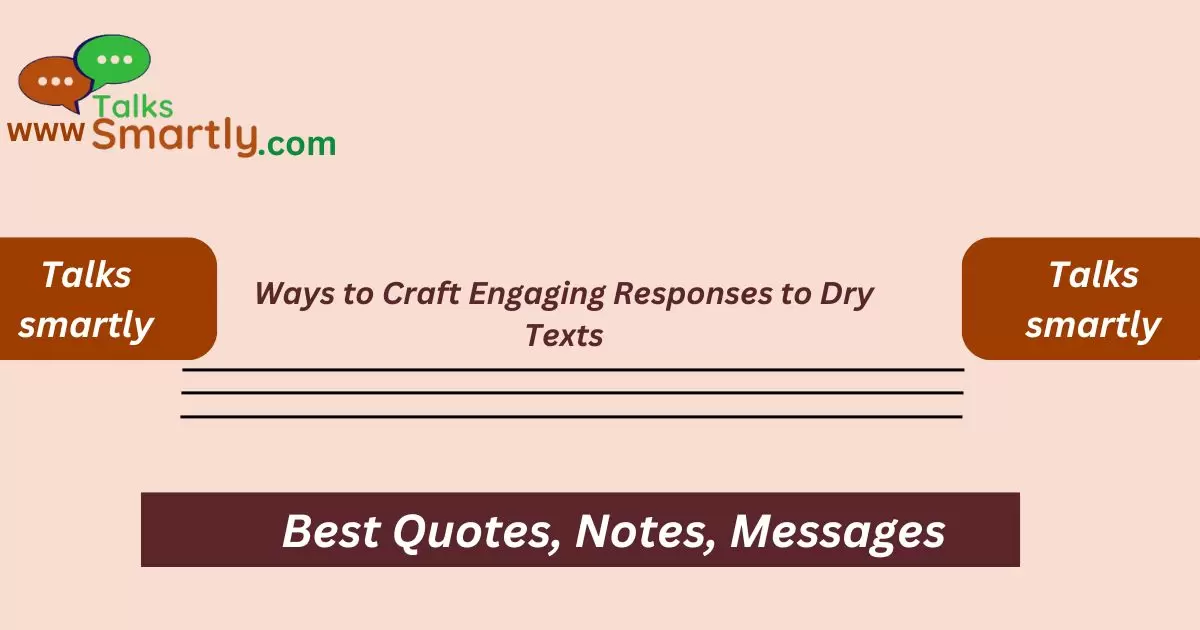“195+ ways to craft engaging responses to dry texts and effortlessly turn boring conversations into lively interactions.”
In today’s fast-paced world, communication has become more essential than ever. But sometimes, the texts we receive can feel flat, uninspired, and downright dull. Dry texts can be a real conversation killer, leaving us unsure of how to respond in a way that keeps the dialogue lively and interesting.
This article is here to help you navigate those tricky moments. Whether it’s a boring message from a colleague or a lacklustre reply from a friend, you’ll find creative and engaging responses to bring the conversation back to life. By the end, you’ll have a wealth of ideas to ensure your texts are anything but dry.
So, if you’re tired of struggling with uninspired conversations, read on to discover 195+ ways to transform those dull texts into meaningful, enjoyable exchanges. Let’s dive in!
Best Replies to the Question: “Are You Sure?”
Characteristics of Dry Texts
- Lacks Emotion: Dry texts often lack any emotional tone, making them feel robotic.
- Short and Vague: They are typically brief, with little context or detail.
- Minimal Engagement: There’s little to no effort to continue the conversation.
- Formal Language: Overly formal language can make the text feel stiff.
- No Humor or Personality: These texts don’t reflect any personal flair or humor.
- Predictable Responses: The content is often generic and expected.
- Monotone Writing Style: The writing lacks variation in tone and energy.
- Absence of Questions: They don’t prompt further conversation or questions.
- Lack of Enthusiasm: There’s no excitement or interest in the text.
- Impersonal Feel: They may feel distant or disconnected.
- Repetitive Phrasing: The use of the same phrases over and over.
- Overly Structured: Texts that are too rigid in structure can feel unnatural.
- Too Informational: Focused solely on facts without any personal touch.
- Limited Vocabulary: Using the same words repeatedly without variation.
- Non-Interactive: No call to action or request for feedback.
Responses to Dry Texts
- “That sounds interesting! Can you tell me more?”
- “Wow, that’s something I hadn’t considered. How did you come to that conclusion?”
- “I see what you mean. What do you think about [related topic]?”
- “That’s a unique perspective! I’d love to hear more about your thoughts on this.”
- “Thanks for sharing that. How do you feel about it?”
- “I appreciate the info! What’s your take on the solution?”
- “That’s a great point. What led you to that conclusion?”
- “I can relate to that. What else do you think about it?”
- “Interesting viewpoint! How does that impact your approach?”
- “I hadn’t thought of it that way. What else is on your mind?”
- “That’s intriguing! What other ideas do you have?”
- “Thanks for sharing. How does this fit into the bigger picture?”
- “I’m curious about your process. Can you walk me through it?”
- “That’s a solid point. What other factors are you considering?”
- “You’ve got me thinking. What are your next steps?”

Why Dry Texts Are Problematic
- Kills Conversation Flow: Dry texts often lead to awkward pauses or dead ends in the conversation.
- Reduces Engagement: People are less likely to respond to a text that feels uninteresting.
- Lacks Connection: These texts can make the sender seem distant or uninterested.
- Misses Emotional Cues: Without emotion, the conversation can feel mechanical.
- Can Be Misinterpreted: The lack of tone can lead to misunderstandings.
- Feels Disconnected: The recipient may feel like there’s no real engagement.
- Fails to Build Rapport: Relationships thrive on engaging communication, which dry texts lack.
- Boring for the Reader: The reader may lose interest quickly.
- Limits Information Sharing: Dry texts don’t encourage a deeper exchange of ideas.
- Creates Frustration: The recipient might feel frustrated by the lack of effort.
- Reduces Motivation to Respond: It can be hard to find the energy to reply to a dull text.
- Impersonal Communication: These texts don’t foster a sense of connection.
- Doesn’t Encourage Follow-Up: The recipient may not feel compelled to continue the conversation.
- Can Lead to Miscommunication: Lack of clarity or tone can cause confusion.
- Hinders Collaboration: In a work setting, dry texts can reduce the effectiveness of teamwork.
How to Identify Dry Texts
- Look for Short Replies: If a text is only a few words, it may be dry.
- Check for Lack of Emotion: Texts that don’t convey any feelings are often dry.
- Notice Vague Language: If the language is unclear or non-specific, it could be dry.
- Watch for No Questions: Texts that don’t ask for your input might be dry.
- Scan for Repetition: Repeated phrases or words can indicate a lack of creativity.
- See if It’s Too Formal: Overly formal texts often lack warmth and personality.
- Examine the Tone: If the tone feels flat or monotone, the text may be dry.
- Assess the Engagement Level: Texts that don’t invite further conversation are likely dry.
- Consider the Context: If the text doesn’t add anything new to the conversation, it might be dry.
- Check for Personal Connection: Dry texts often lack a personal touch.
- Identify Lack of Enthusiasm: If the text feels unexcited, it’s probably dry.
- Review for Detail: A lack of detail or context can make a text feel dry.
- Observe the Structure: Texts that are too rigid or structured can be dry.
- Detect Lack of Variation: Monotone language or style is a sign of dryness.
- Notice Absence of Humor: If there’s no lightness or humor, the text may be dry.
Strategies to Revive Dry Texts
- Inject Humor: Adding a light-hearted joke can bring the text to life.
- Ask Open-Ended Questions: Encourage more conversation with questions that require more than a yes or no answer.
- Share a Personal Story: Personal anecdotes can make the text feel more engaging.
- Use Emojis Wisely: A well-placed emoji can add tone and emotion to a text.
- Expand on the Topic: Add more details or information to enrich the conversation.
- Relate to Their Experience: Show empathy or understanding by connecting to what they’ve said.
- Introduce New Ideas: Bring fresh perspectives or ideas to keep the conversation moving.
- Show Enthusiasm: Express excitement or interest in what they’re saying.
- Provide Feedback: Give your thoughts or opinions to add depth to the conversation.
- Incorporate Questions: Asking follow-up questions can keep the dialogue going.
- Use Positive Language: Positive wording can make the conversation more enjoyable.
- Offer Compliments: A sincere compliment can soften a dry text.
- Be Creative: Don’t be afraid to think outside the box and surprise the recipient.

- Change the Topic: If the current topic is stale, introduce a new subject.
- Acknowledge Their Effort: Recognize the effort they’ve put into the conversation, even if it’s dry.
Practical Tips for Writing Engaging Texts
- Use Conversational Tone: Write as if you’re speaking to the person directly.
- Add Humor When Appropriate: Light jokes can make your texts more engaging.
- Vary Your Sentence Structure: Mixing short and long sentences keeps the reader interested.
- Include Relevant Details: Adding specifics can make your text more engaging.
- Ask Open-Ended Questions: These encourage more detailed responses.
- Use Active Voice: Active voice makes your text feel more dynamic.
- Incorporate Personal Touches: Mention something personal to the recipient.
- Use Visuals: Attach an image or gif to add interest.
- Express Enthusiasm: Show excitement or interest in what you’re discussing.
- Be Concise: Keep your texts clear and to the point.
- Emphasise Important Points: Bold or highlight key information to make it stand out.
- Provide Context: Ensure the recipient has enough information to understand your text.
- Avoid Overly Formal Language: Keep it casual unless the situation demands formality.
- Use Positive Language: Focus on the positive aspects of what you’re discussing.
- Follow-Up: If the conversation stalls, follow up with a new question or topic.
Examples of Dry vs. Engaging Texts
Example 1: Business Email
Dry Text:
“Please find the attached report.”
Engaging Response:
“Hi Daniel, I’ve attached the report you requested. I’d love to hear your thoughts on the findings, especially the trends we noticed in Q2. I’m keen to get your feedback!“
Example 2: Blog Post
Dry Text:
“The product has been released.”
Engaging Response:
“We’re thrilled to announce the release of our latest product! As demonstrated in our testing, it’s packed with features that will make your life easier. Let us know what you think!“
Example 3: Social Media Update
Dry Text:
“New update available.”
Engaging Response:
“Exciting news! We’ve just rolled out a new update packed with features you’ll love. Dive in and explore what’s new, and we’d love to hear your feedback!“
Tools and Resources for Improving Texts
- Grammarly: For checking grammar and improving readability.
- Hemingway Editor: Helps simplify complex sentences.
- Thesaurus.com: Find synonyms to avoid repetition.
- Canva: Create visuals to accompany your texts.
- Giphy: Add gifs to make your texts more lively.
- ProWritingAid: Offers in-depth text analysis and suggestions.
- Evernote: Organise and store your writing ideas.
- Trello: Manage your writing projects with ease.
- Google Docs: Collaborate on texts in real-time.
- Slack: Enhance team communication with fun text features.
- CoSchedule Headline Analyzer: Improve your text headlines.
- AnswerThePublic: Find what people are asking and write engaging content.
- Yoast SEO: Optimise your text for search engines.
- RescueTime: Track your writing productivity.
- Write or Die: A tool that encourages you to keep writing.
Common Mistakes to Avoid
- Being Too Formal: Overly formal texts can come off as stiff and unengaging.
- Using Jargon: Avoid industry-specific jargon that the recipient may not understand.
- Overloading with Information: Don’t overwhelm the recipient with too much detail.
- Ignoring Tone: Ensure your tone matches the context of the conversation.
- Failing to Ask Questions: Not asking questions can make the conversation one-sided.
- Repeating Yourself: Repetition can make your texts feel monotonous.
- Overcomplicating Language: Keep your language simple and easy to understand.
- Skipping Personalization: Personalising your texts makes them more engaging.
- Being Too Brief: Overly short texts can seem abrupt or uninteresting.
- Ignoring Context: Ensure your response is relevant to the conversation.
- Lacking Enthusiasm: Show interest in the conversation to keep it lively.
- Not Following Up: Always follow up if the conversation starts to lag.
- Using Too Many Emojis: While emojis can add tone, overusing them can make your text seem unprofessional.
- Neglecting Visuals: A picture or gif can add a lot to your text.
- Forgetting to Proofread: Always check for typos or errors before sending.
Conclusion
Engaging in lively and meaningful conversations is an essential skill in both personal and professional settings. Dry texts can hinder communication, but with the right strategies, you can turn any conversation around.
By applying the tips and responses outlined in this article, you’ll be well-equipped to transform any dull exchange into a vibrant dialogue that keeps both parties interested and engaged. So next time you receive a dry text, you’ll know exactly how to respond!
Answer to key Question
- What is a dry text?
A dry text is a message that lacks emotion, detail, or engagement, making it feel boring or uninteresting. - How can I make my texts more engaging?
You can make your texts more engaging by using a conversational tone, adding humour, asking open-ended questions, and using visuals. - Why are dry texts problematic?
Dry texts can kill conversation flow, reduce engagement, and create a sense of disconnect between the sender and receiver. - What tools can help improve my text writing?
Tools like Grammarly, Hemingway Editor, and Canva can help improve grammar, simplify sentences, and add visual interest to your texts. - How do I identify if a text is dry?
Look for characteristics like short replies, lack of emotion, vague language, and absence of questions. If a text feels flat or uninspired, it may be dry.












